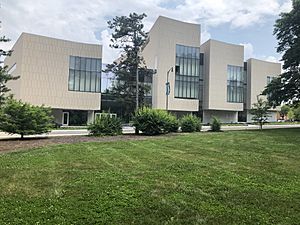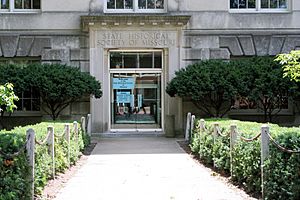State Historical Society of Missouri facts for kids
The State Historical Society of Missouri is a special place in Columbia, Missouri. It's like a giant library and museum that collects and studies everything about Missouri's history and culture. It was started in 1898 by a group called the Missouri Press Association. In 1901, it became the official historical society for the state of Missouri.
The Society is located on the campus of the University of Missouri. It publishes a magazine called Missouri Historical Review, which is the only scholarly history journal in the state. The Society also has many programs to share Missouri's history with everyone. These include theater shows, speakers, and history conferences.
The Society has a huge collection of historical items. It has over 460,000 books and pamphlets, more than 500,000 old letters and documents, 2,900 maps, and over 150,000 state records. They also have many old newspapers on microfilm.
How the Society Started
People had talked about starting a state historical society for a few years. But it really began in January 1898 at a meeting of the Missouri Press Association. Two important people who helped were Edwin W. Stephens and Walter Williams. They got a lot of support from the University of Missouri.
Just four months later, in May 1898, the Missouri Press Association voted to create the State Historical Society of Missouri. Edwin W. Stephens became its first president, and Walter Williams became its secretary.
The Society's leaders wanted the state to officially recognize them. In 1899, the governor signed a law that made the Society a trustee of the state. This meant the state trusted the Society to take care of its history. In 1901, the Society received its first money from the state to help it operate.
The 1899 law explained what the Society should do. It said the Society should collect books, maps, and other materials to study history, especially Missouri's history. It also said they should gather stories from pioneers, old documents, and pictures to show Missouri's past and present.
Newspapers were a very important part of the Society's first collections. This was because of its strong connection with newspaper editors. People could become members by donating their newspapers each year. After ten years, they could become lifetime members.
In 1901, the collection grew even more when Francis Asbury Sampson donated nearly 2,000 books and 14,000 pamphlets. He also convinced another group to donate many books, pamphlets, and maps. The Society also created an exhibit about Missouri newspapers for the 1904 St. Louis World's Fair. Around this time, they also started publishing the Missouri Historical Review.
As the collection grew, the Society needed more space. They moved into the newly built Ellis Library in 1915. This library became their home for many years.
The Shoemaker Years
Around the same time, Floyd C. Shoemaker joined the Society. He worked there for 45 years and achieved many great things. One of his goals was to make the Society's membership the largest in the country. The number of members grew from 1,285 in 1916 to 3,356 in 1936.
During the Great Depression, the Society helped with some government programs. They hired young men and women to help move books, update files, and index newspapers.
George Mahan also helped the Society a lot. He donated money to buy books for the Society's Mark Twain collection. He also paid for 29 roadside historical markers along U.S. Highway 36 from St. Joseph to Hannibal. The Society's staff researched and wrote the words for each marker. Over the years, the Society expanded this program, placing historical markers all over the state.
Floyd Shoemaker also worked hard to get more items for the Society's collection. In 1932 alone, he helped bring in over 1,200 books, 900 pamphlets, paintings, photographs, and many other historical items.
Shoemaker also wanted the Society to publish more. From 1925 to 1939, they published a series of articles called This Week in Missouri History. These articles appeared in newspapers across most of Missouri. The Society also worked on a 20-volume project called The Messages and Proclamations of the Governors of the State of Missouri, which included information about Missouri's governors. Shoemaker was very proud of the Missouri Historical Review, believing it was one of the best publications of its kind.
The Center for Missouri Studies
On August 10, 2019, a new building called the Center for Missouri Studies opened in Columbia. This large public building replaced Ellis Library as the main home of the State Historical Society of Missouri. It has much more space for displaying collections, a bigger library, classrooms, offices, and even an art restoration lab. The Center for Missouri Studies is located on Elm Street in Downtown Columbia, near Peace Park.
Collections and Exhibits

The Society has a large collection of art by famous Missouri artists like George Caleb Bingham and Thomas Hart Benton. In total, the Society owns over 4,000 pieces of art. These include paintings, drawings, and prints. They also have a collection of editorial cartoons by artists like Daniel Fitzpatrick and Bill Mauldin, who was famous during World War II. The Society also has many photographs and maps.
The State Historical Society of Missouri often changes its art and history exhibits. All exhibits and collections are open for the public to visit and enjoy.
George Caleb Bingham Art

One of the most important artists in the Society's collection is George Caleb Bingham. He grew up and lived in Missouri. He is famous for his paintings of everyday life on Missouri's rivers and for his portraits. One of his most well-known paintings is General Order No. 11. This painting shows people being forced to leave their homes in western Missouri during the American Civil War. The Society has one of the largest collections of Bingham's artwork in the country.
Jon Luvelli Photography
The Society also has a collection of photographs by Jon Luvelli. He is a street photographer known around the world for his unique pictures of small towns in rural America. Luvelli grew up in a farm town in Mid-Missouri. His work shows what life is like in the small towns and country roads of Missouri today.
Daniel Fitzpatrick Cartoons
Daniel R. Fitzpatrick was a cartoonist for the St. Louis Post Dispatch newspaper. He won the Pulitzer Prize twice. The Society has one of the largest collections of his work, with over 1,500 original cartoon drawings. His cartoons often showed his thoughts on social and political issues, especially during the World War I era.
Libraries and Research
The Society's Newspaper Library has the biggest collection of Missouri newspapers in the country. It includes the very first newspaper published in Missouri in 1808. You can read thousands of newspapers on microfilm at the Society or borrow them through other libraries. The Society has at least one newspaper from each of Missouri's 114 counties.
In 2008, the Society was chosen to help digitize old newspapers. This means they turned old newspapers into digital files that can be viewed online. Some newspapers from the Society's collection from 1880 to 1922 can be found on the Chronicling America website. The Society also has digital newspapers available on its own website.
The Society's Reference Library has over half a million books and other published materials about Missouri and the Midwest. This includes family histories, county histories, city directories, and scholarly journals. One special collection is the J. Christian Bay Collection, which focuses on the history of the American West.
Historical Manuscript Collection
The Western Historical Manuscript Collection used to be a joint collection between the University of Missouri and the Society. It had different historical materials at various locations across the state. For example, the Kansas City location focused on Kansas City history, and the St. Louis office focused on St. Louis history. The Columbia location focused on the history of the entire state of Missouri.
In 2011, this collection became part of the State Historical Society. You can now find these historical documents and collections at the Society's Research Center in Ellis Library and at other research centers in Kansas City, St. Louis, Rolla, Cape Girardeau, and Springfield.
Outreach Programs
The Society has many programs to share history with the public.
- Missouri History in Performance (MoHiP): This program creates theater performances about moments in Missouri history. Playwrights often use old plays, personal letters, and newspaper stories to create these shows.
- Missouri History Speakers' Bureau: For almost 40 years, the Society has provided speakers to groups and organizations across the state. These speakers talk about different parts of Missouri's history.
- Missouri Conference on History: Each year, the Society holds a multi-day event where people give talks on Missouri history topics. Awards are also given for the best book, best article, and best student paper about state history.
Publications
Besides its programs, the Society also publishes materials to reach the public. They publish the Missouri Historical Review, a quarterly newsletter for members called the Missouri Times, and various books. The Missouri Historical Review has been published since 1906. It features articles and book reviews about Missouri history. In 2006, the Society published special collections celebrating 100 years of the Review on topics like the Civil War in Missouri.
National History Day in Missouri
Since 1989, the State Historical Society of Missouri has sponsored National History Day in Missouri. This is a state-level contest for National History Day. More than 2,400 students from across Missouri take part in this contest. Over 500 students move on to the state competition. Then, 50-55 students from Missouri go on to the national contest in Washington, D.C.. Students can compete in five categories: documentary, exhibit, paper, performance, and website.
Missouri Conference of History
The Missouri Conference of History brings together history teachers and professional historians. They share their research, talk about teaching methods, and discuss ways to promote interest in history. The conference takes place every year at the University of Missouri-Kansas City.








